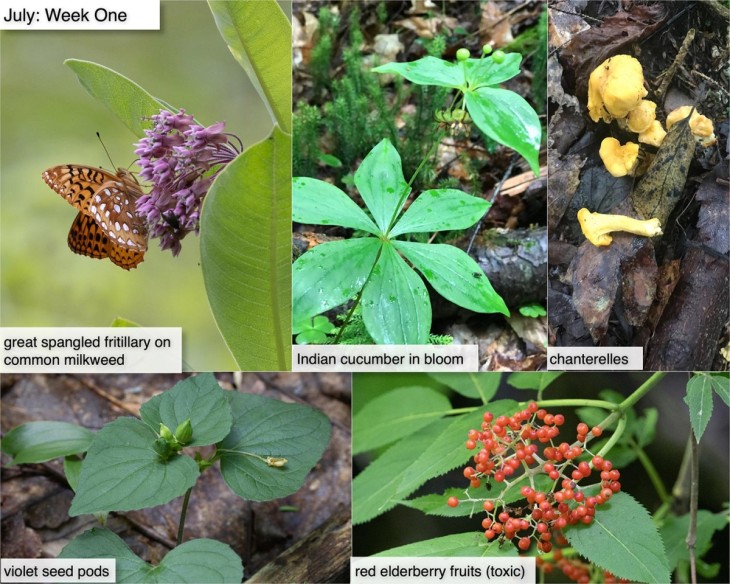This week in the woods, we’ve reached summer’s second act. Spring blooming plants are producing seeds and fruits, and suddenly, butterflies seem to be everywhere.
Monarchs aren’t the only big orange butterflies visiting milkweed patches. Great spangled fritillaries are also fluttering around, especially in areas that include patches of violets, the butteflies’ larval host plants. An identifying feature of this species is the wide apricot band in between white spots on their back-hind wings. Aphrodite fritillaries also have these bands, but they’re typically narrower. Fun fact: the word “fritillary” derives from the Latin fritillus, which means “dice box,” and probably refers to the dice-like checking on these butterflies’ wings. If you’re now curious, as we were, what Roman dice looked like, check out this article from Popular Mechanics.
The flowers of Indian cucumbers don’t get much attention. They’re small, a bit spidery looking, and tucked below the plant’s top whorl of leaves. But take a moment to check them out, and to admire the plants funky multiple whirl growing pattern (did Dr. Seuss encounter these, when he was at Dartmouth?). By the end of the summer, the plants will produce glossy blue berries.
Also showing up in moist hardwood forests now are chanterelles. As ever with foraging fungi, be very careful that you really know what you’ve found, before contemplating any culinary adventures. For example, as noted in this helpful guide from the Missouri Department of Conservation, chanterelles always grow on soil, and do not have true gills.
The clustered fruit of red elderberries are ripening. This forest shrub produces flowers at about the same time as bloodroot, cohosh, and other spring wildflowers. It’s a great wildlife plant (many mammals and birds eat the fruit), and its beauty would also be a nice addition to native gardens. However, note that the fruit often make people sick, and as for the leaves, they’re laced with cyanide.
Finally, circling back to violets, you can now see their seed pods perched above the flowers. As the pods dry out and shrink, they become pressurized and eventually pop open, propelling the seeds in different directions. This is one of those cool distribution techniques by plants that go mostly unnoticed by humans. Other examples of plants that go ballistic to spread seeds are dwarf mistletoe and jewelweed.
What have you noticed in the woods this week? Submit a recent photo for possible inclusion in our monthly online Reader Photo Gallery.


